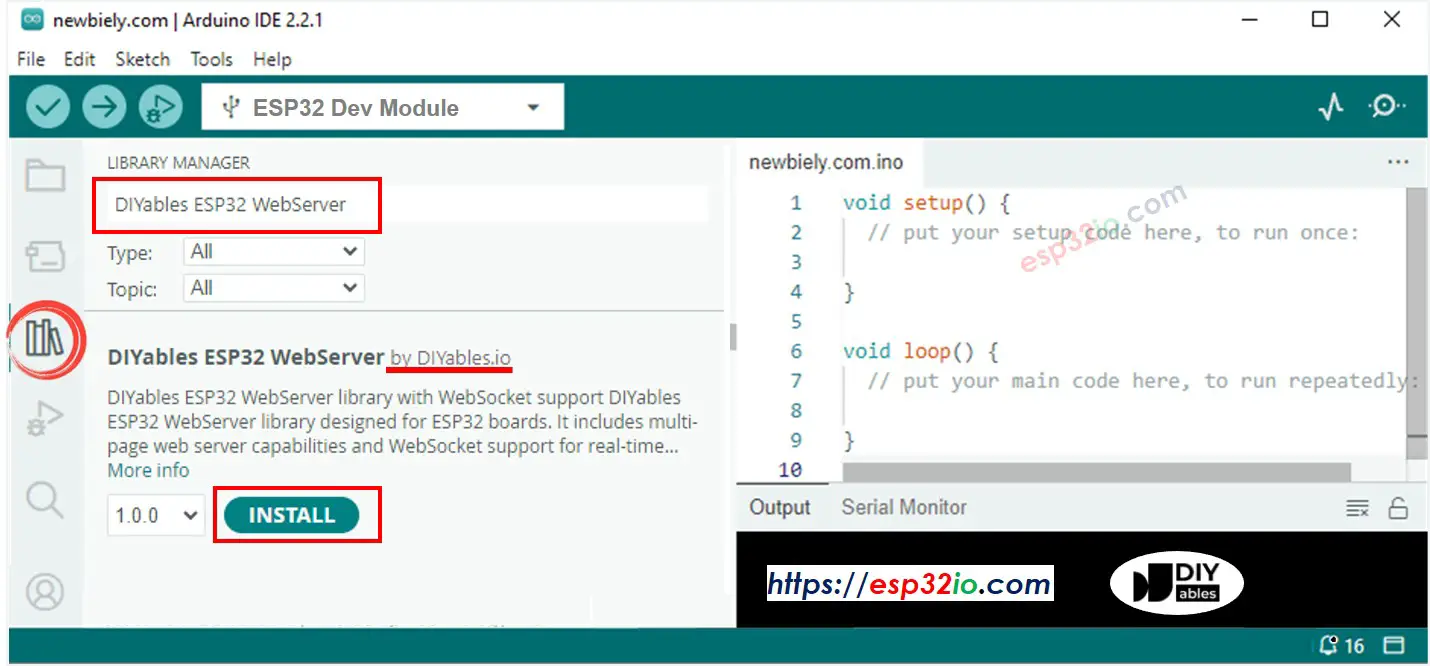DIYables ESP32 Web Server Json Example
WebServerJson Example - REST API Server
Overview
This example demonstrates how to create a REST API server on ESP32 that handles JSON requests and responses, perfect for modern web applications and mobile app backends.
Features
- REST API endpoints with JSON request/response handling
- POST request processing with JSON data parsing
- GET endpoints for data retrieval
- Professional JSON responses with proper HTTP status codes
- Error handling with appropriate JSON error messages
- CORS support for cross-origin requests
Hardware Used In This Tutorial
Or you can buy the following kits:
| 1 | × | DIYables ESP32 Starter Kit (ESP32 included) | |
| 1 | × | DIYables Sensor Kit (30 sensors/displays) | |
| 1 | × | DIYables Sensor Kit (18 sensors/displays) |
Library Installation
Follow these instructions step by step:
- If this is your first time using the ESP32, refer to the tutorial on setting up the environment for ESP32 in the Arduino IDE.
- Connect the ESP32 board to your computer using a USB cable.
- Launch the Arduino IDE on your computer.
- Select the appropriate ESP32 board (e.g., ESP32) and COM port.
- Open the Library Manager by clicking on the Library Manager icon on the left side of the Arduino IDE.
- Search for Web Server for ESP32 and locate the mWebSockets by DIYables.
- Click on the Install button to add the mWebSockets library.

Web Server Json Example
- On Arduino IDE, Go to File Examples Web Server for ESP32 WebServerJson example to open the example code
API Endpoints
GET /api/data
Returns a success message with timestamp in JSON format.
Response:
The timestamp value represents milliseconds since the ESP32 started (from millis() function).
POST /api/data
Accepts JSON data and returns the received key value.
Request:
Response:
Setup Instructions
1. Network Configuration
Edit the WiFi credentials in the WebServerJson.ino file:
2. Upload Code and Monitor Output
- Connect your ESP32 to your computer
- Select the correct board and port in Arduino IDE
- Upload the WebServerJson.ino sketch
- Open Serial Monitor (9600 baud)
- Wait for WiFi connection
- Note the IP address displayed
- If you do not see IP address in Serial monitor, press the reset button on the ESP32 board
Usage
Testing with cURL
Replace your-esp32-ip with the actual IP address shown in your Serial Monitor.
Test GET Request
Expected Output:
The timestamp shows milliseconds since ESP32 startup.
Test POST Request with JSON Data
Expected Output:
Test POST Request with Different Data
Expected Output:
Test Invalid JSON (Error Response)
Expected Output:
Test Missing JSON Body (Error Response)
Expected Output:
Test Unsupported Method (Error Response)
Expected Output:
Test Non-existent Endpoint (404 Error)
Expected Output:
Testing with Postman
Test GET Request
- Create a new GET request
- Set URL to http://your-esp32-ip/api/data
- Send request
- Verify response contains status, message, and timestamp
Test POST Request
- Create a new POST request
- Set URL to http://your-esp32-ip/api/data
- Add header: Content-Type: application/json
- Add JSON body: {"key": "test_value"}
- Send request
- Verify response shows the received key value
Testing Error Responses
Test the error handling by sending invalid requests as shown in the example code:
Missing JSON Data
Expected: {"status": "error","message": "No JSON data received"}
Invalid JSON Format
Expected: {"status": "error","message": "Invalid JSON"}
Missing Key Field
Expected: The key will default to "none" as per the example code: doc["key"] | "none"
Unsupported HTTP Method
Expected: {"status": "error","message": "Method not allowed"}
Code Explanation
Route Configuration
Handler Function Signature
All handler functions must follow this signature:
Method Detection and JSON Processing
Integration Examples
JavaScript Frontend
Python Client
Control LED
Get status
Usage
Error Handling
HTTP Status Codes
- 200: Success
- 400: Bad Request (invalid JSON, missing parameters)
- 404: Endpoint not found
- 405: Method not allowed
- 500: Internal server error
Error Response Format
Based on the actual example code, different errors return specific messages:
Missing JSON Data Error
Returned when: POST request is sent without JSON body
Invalid JSON Format Error
Returned when: JSON data cannot be parsed (syntax errors)
Method Not Allowed Error
Returned when: Using unsupported HTTP methods (PUT, DELETE, PATCH, etc.)
404 Not Found Error
Returned when: Accessing non-existent endpoints
Customization
Adding New Handler Functions
Template-Based JSON Responses
The example uses template strings for consistent JSON formatting:
Troubleshooting
Common Issues
Connection Issues
If you can't connect to the API endpoints:
- Verify your ESP32 is connected to WiFi (check Serial Monitor)
- Ensure your client and ESP32 are on the same network
- Check that the IP address is correct
- Verify the ESP32 hasn't reset (which would change the IP)
JSON Parsing Errors
If you get "Invalid JSON" responses:
- Ensure Content-Type header is set to application/json
- Verify your JSON syntax is valid
- Check that special characters are properly escaped
- Make sure the JSON payload isn't too large (current limit: 200 bytes)
POST Request Issues
If POST requests return "No JSON data received":
- Verify you're sending a JSON body with the request
- Check that Content-Length header is set correctly
- Ensure the HTTP method is actually POST
- Test with a simple JSON like {"key": "test"}
Memory Issues
If the ESP32 becomes unresponsive:
- Monitor memory usage - the StaticJsonDocument uses 200 bytes
- Reduce JSON_RESPONSE template size if needed
- Consider using DynamicJsonDocument for variable-sized data
- Check for memory leaks in custom handler functions
Performance Tips
Optimize JSON Processing
Efficient Response Handling
Next Steps
- Explore WebServerQueryStrings.ino for URL parameter handling
- Try WebServerWithWebSocket.ino for real-time communication
- Consider integrating with databases or cloud services
